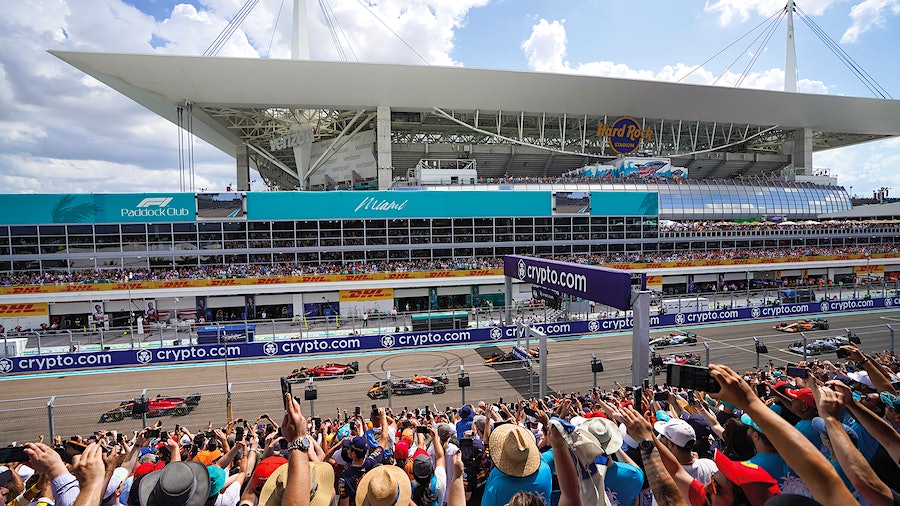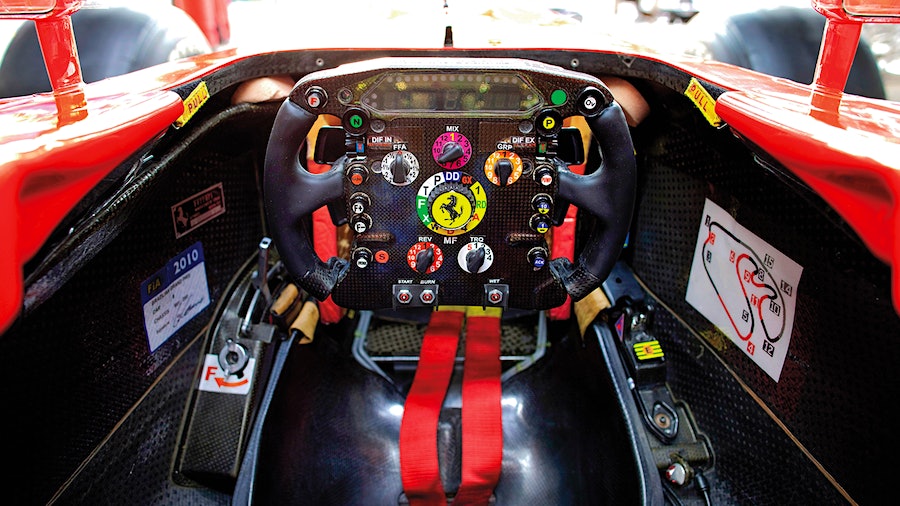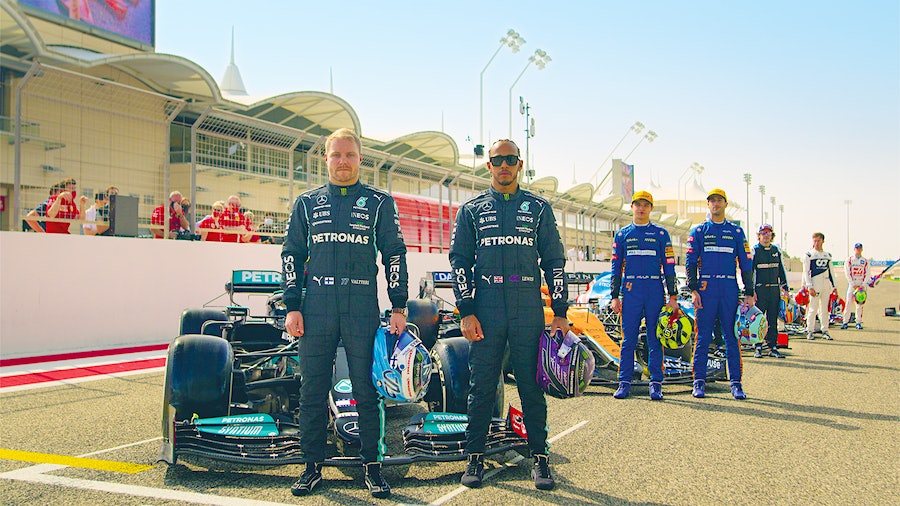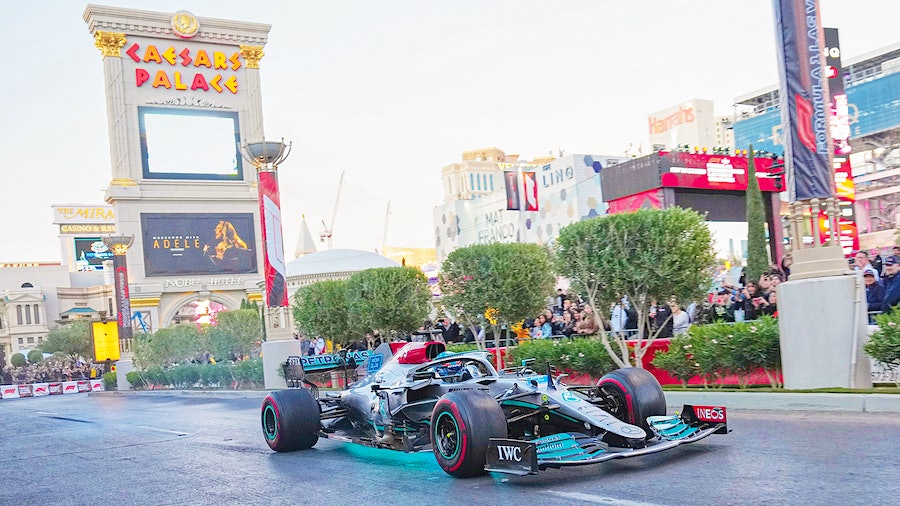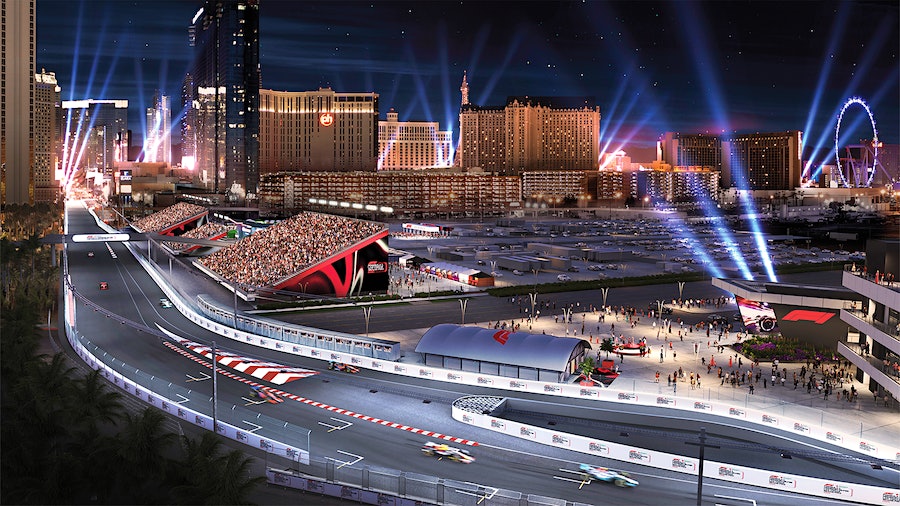The Winning Formula

It’s standing room only. From the sweaty middle of the room, a glance around confirms precisely what you’d expect to see in a hip New York City bar at the height of summer: A fashionable crowd near perfectly split between men and women and trending well under 40 years old.
But a few things are off. The sound system, for one: there’s no music, no dancing, only tense conversation as folks jostle and crane to see the TVs blaring from the walls. Your sense of time is off, too—because, despite the late-night venue, it’s 9:45 on a Sunday morning. Everyone is here to watch the Formula 1 race unfolding an ocean away.
This scene, playing out in bars and brunch spots across the country from March to November, was once unfathomable to American racing fans. Until recent years, Americans who wanted to watch an F1 race in real-time had but three options: an international flight, a satellite TV subscription or a pub that opened at sunrise to serve a half-dozen hardcore motorsport buffs. It didn’t help that the bulk of the F1 season took place in Central European Time, with occasional jaunts to Asia and the Middle East—meaning a painfully early Sunday wake-up for U.S. viewers. For decades, Formula 1 was a lot like World Cup soccer once was: Nearly ubiquitous in Europe, but a puzzling oddity on our shores.
Then came an ownership shake-up, a Netflix series and a global pandemic—all of which helped Formula 1 take America by storm. Drivers and team members are attaining celebrity status on our shores, and the United States, which has had a spotty past in hosting F1, scheduled three Grand Prix events this year, with the third commandeering the streets of Las Vegas in November.
The stock cars of NASCAR and the speedsters of the IndyCar circuit have long captured America’s imagination, but to the rest of the world, Formula 1 is the pinnacle of auto racing, with the most technologically advanced cars and the highest-paid drivers. The series was founded in 1950 upon the “formula,” a set of rules that governs the vehicles and competitions. Drivers rise through Formula 3 and Formula 2, slower feeder leagues, on their way to the top. Formula race cars have evolved dramatically over the decades, but they stick to a time-honored layout, with a single seat, an open-air cockpit and all four wheels outside the bodywork.
Modern F1 cars are the fastest vehicles to race on road courses, meaning they make both left- and right-hand turns. IndyCar, America’s premier open-wheel racing series, hits higher top speeds on left-turn-only oval tracks, but can’t match F1’s pace in road races. Since 2014, all F1 cars are hybrids, powered by a 1.6-liter turbocharged V6 engine and an electric motor that boosts total output beyond 1,000 horsepower. (IndyCar is set to go hybrid in 2024.)
The F1 cars are capable of monstrous speed—in 2022, driver Kevin Magnusson crested 218 miles an hour while qualifying at the Mexican Grand Prix—but the real trick is how quickly they can take a curve. Wings on the front and rear generate downforce, pressing the cars against the pavement to dramatically improve traction. An F1 car can subject its driver to 6g of lateral force in a turn, nearly five times what today’s fastest street-legal supercars can achieve. Controlling these machines for a 90-minute race requires immense physical stamina and unusual athleticism: Two-time F1 World Champion Fernando Alonso cracks walnuts with his tree-trunk neck muscles as a party trick.
The 2023 F1 season will hold 22 races in 20 countries on a mix of permanent racetracks and temporary city-street courses. Ten teams compete in F1. Each fields two cars per race, each designed and engineered in-house at staggering costs. A single car can represent a $15-million investment—at risk of destruction any time it’s on track. Prize money is doled out by the F1 organization, but a team’s main source of income is corporate sponsors who pay to put their logos on the cars. The highest-performing teams attract the most sponsorship money, which helps them develop the fastest cars and hire the best drivers. Some teams, like Mercedes and Ferrari, are divisions of major automakers; others, like U.K.-based Williams, are strictly in the business of Formula 1. Haas F1, which joined the competition in 2016, is the first U.S.-owned team to race in the series since the mid-1980s.
The reason can be laid to one man. Modern Formula 1, with its skunkworks engineering, celebrity drivers and nine-figure team budgets, is largely the creation of British billionaire and former F1 chief executive officer Bernie Ecclestone. From the mid-1970s to 2017, Ecclestone controlled the commercial side of the racing series, including the enormously profitable TV rights, which made him most of his fortune. (The racing itself is governed by the Fédération Internationale de l’Automobile, or FIA, a Paris-based nonprofit akin to the International Olympic Committee.) In the early days, F1 often featured a United States Grand Prix on its schedule, but under Ecclestone, such events became infrequent. Throughout his career, he showed little interest in expanding F1’s influence in North America.
“The United States was neglected by Formula 1 for a long time,” says Guenther Steiner, team principal for Haas F1. “I don’t know why, I cannot give you a reason. Don’t ask me.”
Then, in 2017, the American broadcast giant Liberty Media purchased the racing series for $4.6 billion, drawing the curtains on the Ecclestone era. The new ownership almost immediately began efforts to undo a decade-long backslide in fan engagement. Internal reports commissioned by Liberty showed the problem: For years, F1 organizers had treated racing coverage as a news product, informing viewers of the finishing order and fastest lap times but shedding little light on the technical and interpersonal machinations that steered the outcome of each race.
Liberty created new ways for fans to interact with the sport, expanding TV and online streaming coverage. An Ecclestone mandate had banned racing footage from being posted online. The new owners reversed it, prioritizing social media. But the company wanted a way to reach new viewers, those not already searching for F1 updates. Liberty envisioned an approach that drew on the drivers, the team bosses and the politics of motorsport to present each race as part of a compelling and dramatic storyline—in other words, reality TV. The new owners pitched Netflix, offering to embed camera crews with the teams competing in the 2018 season. The streaming giant could craft a behind-the-scenes documentary showing everything left out of conventional race-day coverage.
“Formula 1: Drive to Survive” debuted on Netflix in March 2019. It showed a side of F1 that had never been seen, even by dedicated fans. While typical racing broadcasts focus on the competition for the podium—first, second and third place—“Drive to Survive” highlights subplots: Battles for a mid-pack finish, emotional radio conversations and teammates’ rivalries.
Out of 10 teams, two initially turned down Netflix’s cameras. Mercedes and Ferrari each had a four-time World Champion driver—Lewis Hamilton and Sebastien Vettel, respectively—vying for a fifth title in 2018, and the teams anticipated distractions. By focusing away from the first-place fight, season one of “Drive to Survive” gave viewers a more compelling and well-rounded story.
We watched lovable Australian driver Daniel Ricciardo and his dentist-office smile navigate the politics of the Red Bull team, deciding midway through the season to leave for Renault in 2019. We saw struggling Force India get bailed out when the fashion-industry billionaire Lawrence Stroll saved the team on one condition: His son, Lance, would race with the team, leaving drivers Esteban Ocon and Sergio Perez to fight for the remaining seat. We saw American upstart Haas F1 glimpse a chance at fourth place in the World Constructors’ Championship, but end up sixth after a rash of bad luck.
You didn’t have to know anything about racing—or even cars—to jump into “Drive to Survive.” The show steered away from the nuts and bolts of conventional F1 fandom and focused on the human stories. Perhaps, at times, a little too much: Dutch driver Max Verstappen refused to appear in season four of the documentary, accusing producers of exaggerating rivalries. “I’m quite a down-to-earth guy, and I just want it to be facts, don’t hype it up,” Verstappen told The New York Times. Eventually, he agreed to be interviewed for season five, which debuted earlier this year.
“Drive to Survive” made an unlikely star out of Steiner. Born in South Tyrol, a German-speaking province of northeastern Italy, he has been involved in Formula 1 since 2001. In 2014, he debuted as team principle of Haas F1 team, responsible for racing strategy, vehicle development and hiring and firing drivers and staff. Prior to the Netflix documentary, his job had been conducted largely out of sight, but camera crews found a character who drove the documentary’s first season even as his team struggled. His Alpine-accented bluntness and flair for profanity made him a fan favorite. “It’s impacting on my life around the race track,” says Steiner, who gets selfie requests even away from the track. His colleagues have found the same: Zak Brown, chief executive of McLaren Racing, recently told The New York Times, “I can’t go through an airport now without being recognized, and it’s all because of Netflix.”
Season 1 of “Drive to Survive” made a splash in 2019. But more importantly, it put Liberty Media in position to reap enormous benefits when the world shut down in 2020.
Season 2 of “Drive to Survive” launched two weeks before Covid was declared a national emergency in March of 2020. Americans on lockdown were hungry for something to watch on TV. “Drive to Survive” sated many with two 10-episode seasons relating the byzantine drama of the 2018 and 2019 championships. Brandon Riegg, vice president for nonscripted series at Netflix, watched the viewer metrics skyrocket. “All of a sudden, it was like [a] hockey stick,” he told The New York Times.
Furthermore, F1 was forced to cancel five of its races in 2020, delaying its season opener from March to July. The 17 remaining races were almost all closed-door affairs. Lifelong F1 fans turned on the documentary to fill the racing void. Netflix has revealed that “Drive to Survive” is among the top 10 percent of shows that customers binge-watch.
When ESPN took over F1’s U.S. broadcast rights from NBC, each race averaged around 554,000 viewers. By 2022, that number had more than doubled to 1.21 million viewers per race. And it keeps rising: Of the top three most-watched F1 races in terms of U.S. television audience, two have taken place during the 2023 season. When ESPN won the right to air F1 in the U.S., it cost about $5 million a year. After a renegotiation in 2022, the price rose to somewhere between $75 million and $90 million. In 2022, the data firm Morning Consult polled American F1 fans. Fifty-three percent credited “Drive to Survive” for their interest in the series. Among fans under 45 years old, the number was 74 percent.
“I wouldn’t say it’s just down to ‘Drive to Survive,’ ” Steiner says about the show’s role in the rise of F1 in America. “I think the biggest thing is Liberty Media buying Formula 1 and actively working to get into the U.S. properly.”
For decades, F1 struggled to keep a United States Grand Prix on the calendar. For the four years leading up to the 2012 debut of the inaugural race at the newly-constructed Circuit of the Americas racetrack in Austin, Texas, no U.S. races were run. As well as satisfying safety requirements and featuring a course layout with lots of spots for spectators, COTA set itself apart with non-racing attractions. In 2016, Taylor Swift played a sold-out concert the night before the race.
Attendance hovered below 270,000 until 2021, when the U.S. Grand Prix became the most-attended three-day F1 race weekend in history, counting 400,000 spectators. In 2022, it drew 440,000.
That paved the way for the Miami Grand Prix, held on a temporary course laid out on the grounds of Hard Rock Stadium, home of the NFL’s Miami Dolphins. The 2022 debut race shattered U.S. TV records, with 2.6 million viewers tuning in. F1’s second-most-watched TV broadcast? The 2023 Miami Grand Prix, with 1.96 million U.S. viewers.
On November 19, the Las Vegas Grand Prix will send F1 cars flying down the Las Vegas Strip on a mile-long straightaway, where the cars are expected to blast past 210 mph.
This newest F1 event marks an unusual departure, being the first race organized and overseen by Formula 1 itself. Traditionally, F1 picks a new city and delegates the logistics to local race promoters, but Liberty will control all aspects of preparation for this race—including building a permanent paddock structure on 39 acres of downtown Vegas land owned by Liberty.
The Las Vegas Grand Prix will be a true street circuit, built on city roads, which required nearly two inches of fresh, racing-grade asphalt. The paving alone constitutes an $80 million project, split equally between F1 and Clark County. When the safety barriers go up around the race course, a huge chunk of the Strip will become a virtual island, requiring temporary bridges to get people in and out. In all, Liberty estimates it will invest half a billion dollars to launch the Las Vegas Grand Prix. Local officials expect it to be a long-term benefit to Vegas: The county has approved F1’s request to shut down Las Vegas Boulevard annually for the next 10 years and referred to the Grand Prix as “a lifetime in partnership.”
In an interview with the sports website The Athletic, the Liberty Media chief legal and administrative officer Renee Wilm described how her team convinced local officials that they were up to the task. It helped that, in addition to running Formula 1, Liberty owns the Atlanta Braves baseball team and holds stakes in Sirius XM and Live Nation. “So when we came to town and said, ‘We are backing this race, we are promoting it ourselves,’ I think that is when everyone realized, ‘Oh, this can happen,’ ” she said. Once again, “Drive to Survive” helped sell F1: In early 2021, when Covid-related border closures prevented some F1 execs from traveling to Vegas, Wilm encouraged Nevada stakeholders to watch the documentary for a taste of what F1 could bring to Sin City.
Liberty—and Las Vegas—wouldn’t commit to such an undertaking without the promise of a payoff. An economic impact study estimates that the 2023 Las Vegas Grand Prix will bring $1.3 billion to the local economy—more than double the estimated $600 million expected when the city hosts Super Bowl LVIII in February. Tickets—most of which sold out months ago—started at $500 for general admissions, rising to $2,500 for a main grandstand seat, with VIP passes demanding $8,000. Many resorts offered their own package deals that ran well into five figures.
Organizers anticipate as many as 100,000 spectators at the race on Sunday, November 19, with hundreds of thousands more expected to show up for practice and qualifying sessions on the days prior. “We don’t have a venue that seats the number of people who will be at this Grand Prix,” the CEO of the Las Vegas Convention and Visitors Authority Steve Hill told The Athletic, predicting that the race will be “the biggest event in the world in 2023.” The chief operating officer for Wynn Resorts in North America Brian Gullbrants agreed, telling the outlet, “Whether it’s a football game, a soccer game, or anything else, nothing has the reach F1 does.”
With the Las Vegas Grand Prix, the U.S. hosts a nearly unprecedented three races this season. Even Italy—home of Ferrari, the New York Yankees of F1—was awarded only two races on this year’s calendar (one was canceled due to flooding).
One more victory comes with the Las Vegas Grand Prix for U.S. racing fans. The race will begin at 10 p.m. local time on Sunday, to maximize the visual impact of Formula 1 cars screaming past Sin City’s signature lights. Which means that, finally, European fans will be the ones setting an early-morning alarm to watch an F1 race.
